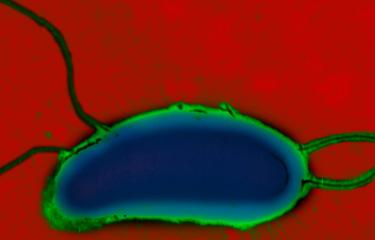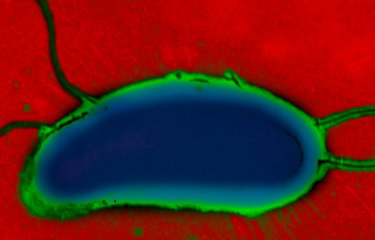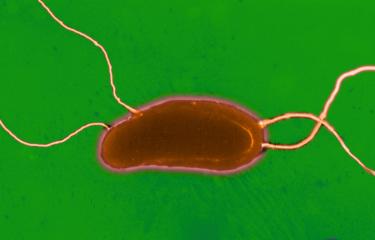Vibrio cholerae, the bacteria that causes cholera, is made pathogenic by one of its parasites, the CTX virus. This virus enables the vibrio to produce a toxin that causes the lethal diarrhea of cholera. Researchers at the CNRS and Institut Pasteur have recently proven, in a work published in Molecular Cell, which adaptive method the CTX bacteriophage uses to propagate itself so effectively in the bacteria that cause cholera. This discovery opens possibilities for developing new treatment tools.
Press release
Paris, september 6, 2005
Vibrio cholerae is the bacteria that causes cholera. Not all Vibrio cholerae are pathogenic. In order to become pathogenic, the vibrio must acquire the ability to produce the cholera toxin, which causes the lethal diarrhea of cholera. The ability to produce this toxin is transferred to the bacteria by a resourceful parasite, the CTX bacteriophage.
Bacteriophages are viruses that infect bacteria. In order to become a parasite of the Vibrio cholerae, the CTX bacteriophage integrates its entire genome in that of the bacteria, thus enabling it to use its host’s reproduction process to propagate itself. In “exchange,” the vibrio acquires the ability to produce the cholera toxin, which is encoded in the genome of the bacteriophage.
Most bacterial genomes, and specifically that of the Vibrio cholerae, consist of circular double-stranded DNA chromosomes. As for the genome of the CTX bacteriophage, it is a circular single-stranded DNA. Researchers at the CNRS and Institut Pasteur recently showed by which mechanism the CTX bacteriophage “hijacks” the cellular machinery of the bacteria to integrate its genome, despite this structural difference.
They demonstrated that a section of the single-stranded viral DNA folds over on itself to form a stem of double-stranded DNA. This stem mimics the target of bacterial enzymes specializing in the recombination of double-stranded DNA that normally maintain the integrity of the vibrio’s genome. These enzymes are able to swap the ends of two separate DNA fragments. The term for this is “crossing over.” Tricked by the virus’s imitation, the enzymes cross the single-stranded viral DNA with the double-stranded bacterial genome, thus causing the viral genome to be integrated in one of the two strands of the bacterial genome DNA. Then, the bacterium copies the section of the viral DNA to the opposite strand to reestablish the double-stranded structure of its genome, which hides the stem of viral DNA that was used as a target for recombination. The bacteria’s enzymes that perform the crossing over are then no longer able to extract the viral DNA from the bacterial genome by inverse crossing. The bacteriophage thus successfully and irreversibly modifies the bacteria’s genetic code. This is the special advantage of this integration mechanism for the virus.
Just like the CTX bacteriophage, many other bacteria “parasites” are responsible for disseminating genes in bacteria that make them infectious or resistant to antibiotics. The integration mechanism of the CTX bacteriophage may be applied to many parasites. In particular, researchers at Institut Pasteur showed that a similar mechanism could explain the acquisition of multiple resistances by Gram-negative bacteria, such as enterobacteria, pseudomonads and vibrios. This work could make it possible to develop new treatment tools for fighting pathogenic bacteria and the propagation of multi-resistant microbe strains.
Sources
"The single-stranded genome of phage CTX is the form used for integration into the genome of Vibrio cholerae " Molecular Cell 19 august 2005.
Marie-Eve Val (1,2), Marie Bouvier (3), Javier Campos (4), David Sherratt (5), François Cornet (2), Didier Mazel (3), François-Xavier Barre (1,2)
1. Centre de Génétique Moléculaire, CNRS Gif sur Yvette Cedex, France
2. Laboratoire de Microbiologie et de Génétique Moléculaires, CNRS Toulouse , France
3. Unité Postulante Plasticité du Génome Bactérien, CNRS-Institut Pasteur, France
4. Departamento de Genetica, Centro Nacional de Investigaciones Cientificas, Havana, Cuba
5. Division of Molecular Genetics, University of Oxford, United Kingdom
Contact presse
Institut Pasteur - Press office
Nadine Peyrolo - Bruno Baron
01 44 38 91 30 - bbaron@pasteur.fr
CNRS - Press office
Gaëlle Multier
01 44 96 46 06 - gaelle.multier@cnrs-dir.fr






